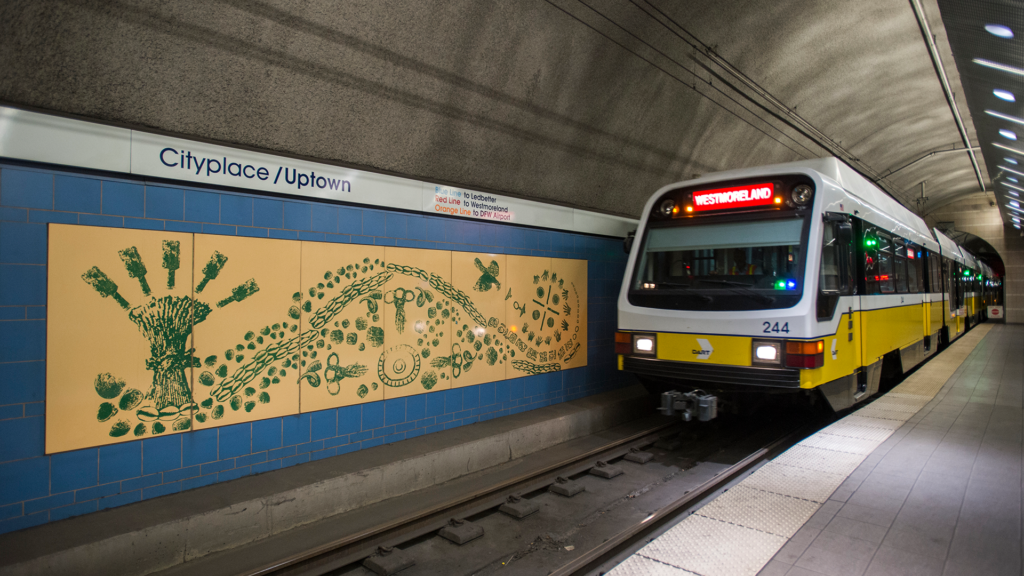Dallas Area Rapid Transit (DART): History and Historical Preservation
April 2025
Author: Melinda Luna PE
The Dallas Area Rapid Transit (DART) system has become a vital part of Dallas’s transportation system. As the city continues to grow and develop, DART plays an important role in shaping its future. But its journey from inception to its current form is entwined with the city’s history and its efforts to preserve historical landmarks. This article explores the history of DART, its development, and how historical preservation has shaped and been impacted by the transit system’s expansion.
The Beginnings of DART: A Growing Need for Public Transit
In the early 1980s, the rapid growth of the Dallas-Fort Worth metropolitan area prompted concerns about traffic congestion, air quality, and the sustainability of the region’s transportation network. Dallas, which had been a car-dependent city, recognized that a reliable and efficient public transportation system was necessary for its long-term growth.
In response, the Dallas Area Rapid Transit (DART) system was created. A public transportation authority, DART was officially established in 1983 after voters approved the plan for a regional transit system. The mission of DART was to reduce congestion, provide greater mobility, and improve the overall quality of life for residents by offering a diverse mix of transit services, including buses, light rail, and commuter rail.
The Rise of the Light Rail System
DART’s signature feature is its light rail system, which began with the opening of the first light rail line, the Red Line, in 1996. The line stretched from the Pearl Street station near downtown Dallas to the northern suburbs of Plano. Over the years, the system expanded significantly, adding multiple lines that reached new areas, including the Blue Line (which opened in 2002) and the Green Line (which opened in 2010). Today, DART’s light rail system spans over 90 miles, with plans for future extensions to ensure that more of the Dallas metroplex is connected.
The light rail has become a critical part of the city’s infrastructure, providing a clean, energy-efficient alternative to car travel and reducing congestion on Dallas highways. Its reach has grown far beyond the city limits, connecting Dallas with surrounding communities, including Irving, Garland, and Richardson.
DART and Historical Preservation
As DART expanded, one of the challenges the system faced was balancing modern development with the preservation of Dallas’s historic sites. Historical preservation has long been an essential aspect of urban planning in Dallas, and the transit system’s design had to respect and integrate the city’s rich history.
The alignment of some DART lines passed through areas that were home to important historical buildings and landmarks. One example is the deep preservation efforts around the landmark West End Historic District, which was preserved while being integrated into the new rail system. The West End is home to a number of historic buildings that date back to the late 19th and early 20th centuries, and DART’s light rail lines needed to work around these sites to protect their historical value.
The Union Station in Dallas, another significant historical landmark, is located at the intersection of several DART light rail lines, including the Red and Blue lines. This iconic station, originally built in 1916 and listed in the National Register of Historic Places, underwent significant restoration work as part of the DART system’s expansion. DART ensured that the building’s historical character and architectural integrity were maintained while integrating it into the modern transportation network. Today, the Union Station serves as a hub for both light rail and commuter rail services, a testament to the city’s commitment to preserving its past while embracing its future.
Moreover, several DART stations have been built to complement their historic surroundings. Stations like the Fair Park Station, which is located near the Fair Park area (home to the Texas State Fair and numerous historic buildings), have been designed with an emphasis on blending in with the existing architecture. Fair Park itself is a National Historic Landmark, and the DART station was constructed to ensure the area’s historic significance was respected.
Preserving Dallas’s Historical Legacy through Transit-Oriented Development
One of the most innovative aspects of DART’s expansion is its focus on transit-oriented development (TOD). TOD seeks to integrate public transit systems with the surrounding community, creating spaces where people can live, work, and play without needing to rely on cars. In Dallas, TOD has become a powerful tool for revitalizing neighborhoods, especially those that are rich in history but in need of investment.
For example, DART’s Deep Ellum Station, located in the Deep Ellum district, is part of a broader effort to revitalize this historically significant area, which was once a center for African American culture and jazz music. The district is home to many historic buildings, and the DART station has been designed to support the area’s artistic and cultural heritage while also bringing new businesses, residents, and investments to the area.
DART’s commitment to TOD has also spurred preservation in areas such as Oak Cliff, a historic neighborhood that has seen considerable development in recent years. By integrating new developments around transit stations with preservation of existing structures, DART has helped maintain the historic charm of these neighborhoods while encouraging sustainable growth.
Future of DART and Historical Preservation
As Dallas continues to grow, DART’s role in transportation and historical preservation will remain vital. Future expansion plans include extending the light rail system further into suburban areas, as well as enhancing connectivity between various transit modes, such as commuter rail, buses, and even bike lanes. With these new developments, DART will need to continue balancing modern transportation needs with the preservation of the city’s architectural and cultural heritage.
Additionally, as the city focuses on increasing green spaces and promoting sustainability, DART’s environmentally friendly approach to transit will play an essential role in Dallas’s efforts to reduce its carbon footprint and protect its historical landmarks. By promoting public transportation over car travel, DART can help limit urban sprawl and protect the city’s historic neighborhoods from being overwhelmed by development.
Conclusion
DART has played a pivotal role in shaping the growth of Dallas, not only in terms of transportation but also in terms of historical preservation. As the system continues to expand, it is evident that a balance between modern transit and historic preservation is crucial for maintaining the identity and charm of Dallas. Through careful planning and thoughtful integration, DART has shown that it is possible to respect the past while embracing the future, ensuring that Dallas’s rich history will be preserved for generations to come. DART has a ridership of 42.7 million passenger trips a year.



